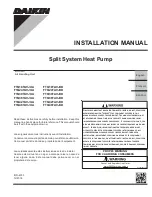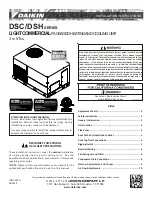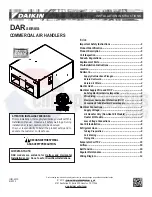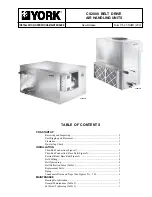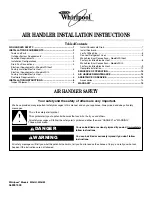
97
BOTTOM RETURN FAN CONNECTIONS
Return air ducts must be attached directly to the return side of the
unit. This applies to both indoor and outdoor units! Use care when
making turns and transitions in ductwork to avoid excessive air
friction. Duct elbows should contain turning vanes. See Fig. 41.
PLENUM FAN DUCT CONNECTIONS
Plenum fans are designed for draw-thru or blow-thru operation.
Draw-thru fan sections have closed panels on all sides except for
the fan inlet side. On blow-thru fan sections, the panel on the end
opposite the inlet is omitted so that components such as coil or fil
-
ter sections can be added downstream from the plenum fan.
NOTE: Duct openings cannot be cut into the bottom of any ple
-
num fan section. An additional discharge plenum MUST be used
for bottom duct opening.
DRAW-THRU PLENUM FAN DISCHARGE FABRICATION
Discharge openings are not allowed through the floor of plenum
fan sections. A separate discharge plenum is the only approved
method for bottom duct connections when using a plenum fan.
Duct openings for draw-thru plenum fans must be field fabricated.
They should be located in the plenum fan section according to the
following guidelines:
• Locate discharge openings in side or top panels; the end
panel opposite the inlet will have a higher pressure drop
per the explanation in the 39M Product Data manual.
• Locate discharge openings on the side or top panels be
-
tween the fan wheel and end panel opposite the inlet. Do
not locate discharges in the direct path of airflow from the
wheel.
• Avoid locating the discharge opening on the motor side of
the fan section. If a discharge on the motor side is neces
-
sary, locate the opening near the top of the cabinet.
• Sizes 36-110 include intermediate frame members. When
cutting the discharge opening for the plenum fan, do not
cut through any intermediate frame member.
Typical duct locations are shown in Fig. 43.
Once the discharge locations are selected and cut, the duct connec
-
tions can be fabricated. Install field-supplied duct flanges and
framing channels to smooth the airflow leaving the discharge
opening. Two of the channels should extend the width or height of
the cabinet to provide additional cabinet support.
Panel Cutting
The 39M unit’s double-wall foam-filled panels require special at
-
tention when cutting and/or penetrating.
1. Take care in planning before penetrating any panel with elec
-
trical conduit, hydronic piping, sensor pickups or wiring.
Once these are routed through a panel, for all practical pur
-
poses, it becomes a fixed panel that is not easily removed for
service access.
2. In some cases it will be possible for smaller conduits (
1
/
2
-in.
or
3
/
4
-in.) to enter the cabinet through the frame rail where
individual sections are joined together. Inspect the selected
area carefully to be certain that you do not encounter shipping
blocks or section joining screws. Once the conduit is in place,
it must be securely sealed, watertight and airtight, to prevent
ANY infiltration.
Penetrations are typically located in one of the existing
“fixed” panels, such as the fan discharge panel or the coil
connection panel, to maximize the number of removable/ser
-
vice panels. When it is necessary to penetrate the panel for
wiring or piping entry, make certain that the entry point will
not interfere with future component servicing, block access
doors, or obstruct airflow.
3. Drill a small pilot hole completely through the panel.
4. Use of a sharp hole saw or, if appropriate, a powered shear
cutting tool or sheet metal nibbler to cut the hole or opening
from each side.
5. Carefully remove the foam. The hole should be lined or
sleeved to confine the foam, and the penetration should be
sealed, both inside and out, to eliminate all possibility of infil
-
tration or leakage.
NOTE: Small quantities of locally available commercial canned
foam may be used, if necessary, to complete minor repairs. Signif
-
icant patching may justify ordering replacement panels instead.
Face and Bypass Dampers
All face and bypass damper sections are shipped fully assembled.
Unit sizes 03-12 are built with a single damper assembly. Sizes
14-110 have multiple damper assemblies linked via a jackshaft:
two assemblies for sizes 14-61; three for sizes 72-96; and four for
size 110. Damper crankarms have 90 degrees of travel from fully
open to fully closed positions and are adjustable to suit conditions.
Refer to Fig. 44 for details.
Actuators must be mounted directly to the damper shaft. Removal
of crankarms is necessary for direct connection actuator use. Refer
to Table 25 for linkage configurations. Refer to Table 26 for oper
-
ating torque requirements.
Table 25 —
Linkage Configurations
* Sizes 50-110 use one actuator per damper.
IMPORTANT: For all sizes with full bottom return openings,
attach ductwork to inside of baserails.
SUPPLY DUCT
DUCT TRANSITION
MAXIMUM
NOT LESS THAN 2-1/2
TIMES FAN DIAMETER
30°
Fig. 42 —
Duct Connections
A39-2260
CAUTION
Do not use a cutting torch or open flame on or near the fan.
Damage to the panel may occur.
LINKAGE CONFIGURATION
Top-Bottom
1 Actuator
Top-Rear
Top-Face*
Rear-Bottom
Side-Rear
NO-LINKAGE CONFIGURATION
Side-Bottom
1 Actuator Per Damper
SIDE-TOP































